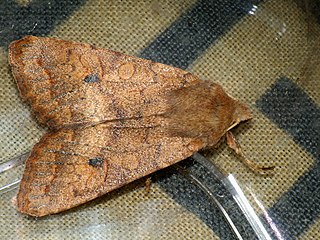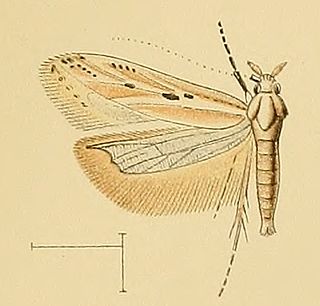
The setaceous Hebrew character is a moth of the family Noctuidae. The species was first described by Carl Linnaeus in his 1758 10th edition of Systema Naturae. It is found in the Palearctic realm. It is a common species throughout Europe and North Asia and Central Asia, South Asia, China, Japan and Korea. It is also found in North America, from coast to coast across Canada and the northern United States to western Alaska. It occurs in the Rocky Mountains from Montana to southern Arizona and New Mexico. In the east, it ranges from Maine to North Carolina. It has recently been recorded in Tennessee.

The beet armyworm or small mottled willow moth is one of the best-known agricultural pest insects. It is also known as the asparagus fern caterpillar. It is native to Asia, but has been introduced worldwide and is now found almost anywhere its many host crops are grown. The voracious larvae are the main culprits. In the British Isles, where it is an introduced species and not known to breed, the adult moth is known as the small mottled willow moth.

Agrochola circellaris, or The Brick, is a species of moth of the family Noctuidae. The species was first described by Johann Siegfried Hufnagel in 1766. It is distributed throughout most of Europe, Asia Minor and Armenia.

Melanitis phedima, the dark evening brown, is a species of butterfly found flying at dusk. The flight of this species is erratic. They are found in south and southeast Asia.

Scopula immutata, the lesser cream wave, is a moth of the family Geometridae. It was described by Carl Linnaeus in his 1758 10th edition of Systema Naturae. It is found throughout Europe.

Agriphila tristella, the common grass-veneer, is a species of moth of the family Crambidae found in Europe and Asia.

Noctua fimbriata, the broad-bordered yellow underwing, is a moth of the family Noctuidae. It is found in Europe, North Africa, Anatolia, the Caucasus, Turkey, Caucasus, Transcaucasia, Armenia, Turkmenistan and Novosibirsk Oblast. The border of its southern range is unclear because of the similar looking species Noctua tirrenica.

Callopistria juventina, the Latin, is a moth of the family Noctuidae. The species is found across the Palearctic realm.

Mesapamea secalis, the common rustic, is a moth of the family Noctuidae. The species was first described by Carl Linnaeus in his 1758 10th edition of Systema Naturae. It is found in Europe, north-west Africa, Turkey and northern Iran.

Philereme transversata, the dark umber, is a moth of the family Geometridae. It is found in much of the Palearctic realm.

Metzneria aestivella is a moth of the family Gelechiidae. It is found in most of Europe, except Iceland, Norway, Lithuania, Slovakia and Ukraine. The habitat consists of dry, sunny areas with low-growing herbaceous plants.
Anacrusis epidicta is a species of moth of the family Tortricidae. It is found in Bahia, Brazil.
Proeulia tricornuta is a species of moth of the family Tortricidae. It is found in the Maule Region of Chile.
Proeulia limaria is a species of moth of the family Tortricidae. It is found in Coquimbo Region, Chile.
Proeulia paronerata is a species of moth of the family Tortricidae. It is found in the Valparaíso Region of Chile.
Vulpoxena dentata is a species of moth of the family Tortricidae. It is found in Napo Province, Ecuador.
Ptyongnathosia lobosaccula is a species of moth of the family Tortricidae. It is found in Peru.
Lasiothyris puertoricana is a species of moth of the family Tortricidae. It is found in Puerto Rico.

Phalonidia aetheria is a species of moth of the family Tortricidae, the subfamily Tortricinae, and the tribe Cochylini. It is found in Brazil, in the states of São Paulo, Santa Catarina and Goias.
Telphusa ochrifoliata is a moth of the family Gelechiidae. It is found in Mexico (Veracruz).











